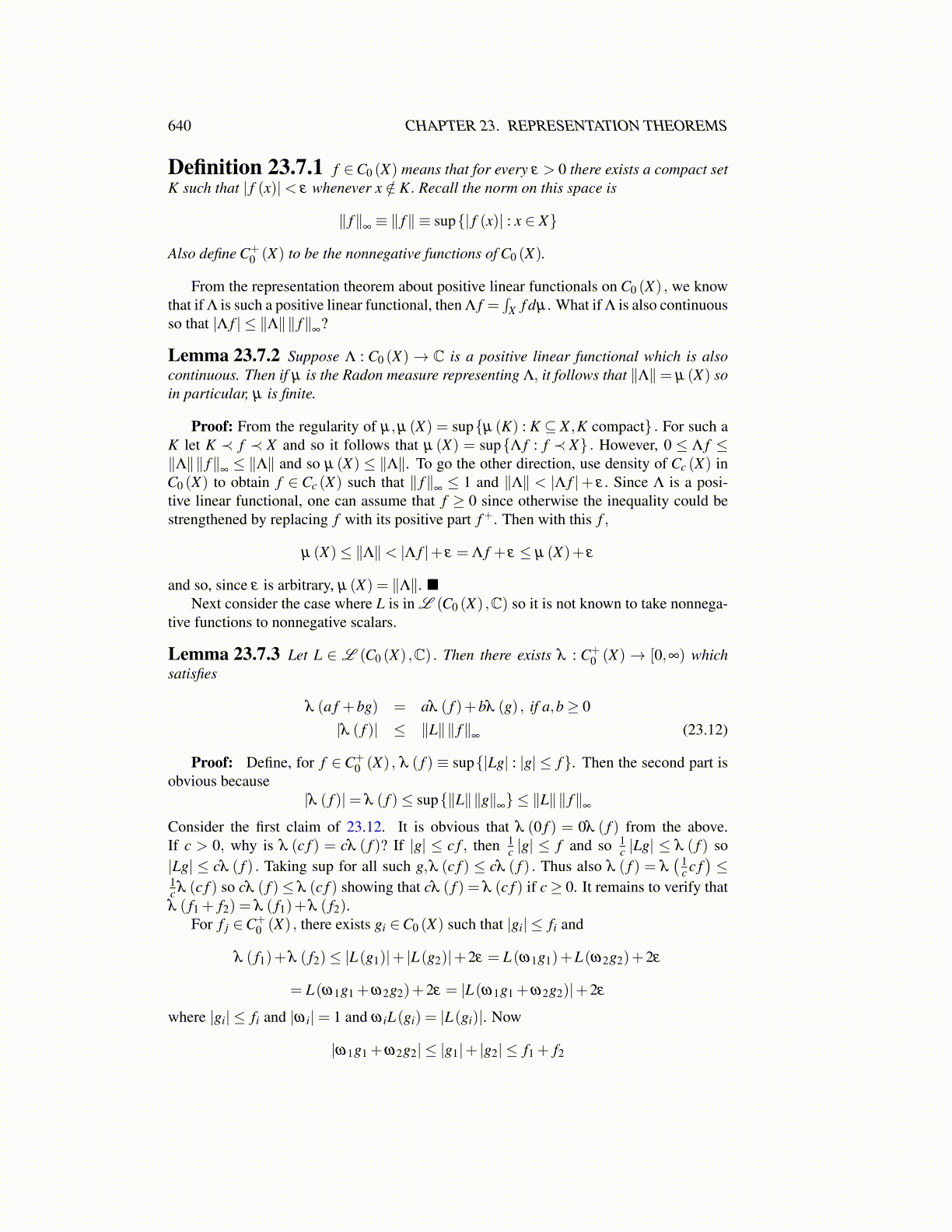
640 CHAPTER 23. REPRESENTATION THEOREMS
Definition 23.7.1 f ∈C0 (X) means that for every ε > 0 there exists a compact setK such that | f (x)|< ε whenever x /∈ K. Recall the norm on this space is
∥ f∥∞≡ ∥ f∥ ≡ sup{| f (x)| : x ∈ X}
Also define C+0 (X) to be the nonnegative functions of C0 (X).
From the representation theorem about positive linear functionals on C0 (X) , we knowthat if Λ is such a positive linear functional, then Λ f =
∫X f dµ . What if Λ is also continuous
so that |Λ f | ≤ ∥Λ∥∥ f∥∞
?
Lemma 23.7.2 Suppose Λ : C0 (X)→ C is a positive linear functional which is alsocontinuous. Then if µ is the Radon measure representing Λ, it follows that ∥Λ∥= µ (X) soin particular, µ is finite.
Proof: From the regularity of µ,µ (X) = sup{µ (K) : K ⊆ X ,K compact} . For such aK let K ≺ f ≺ X and so it follows that µ (X) = sup{Λ f : f ≺ X} . However, 0 ≤ Λ f ≤∥Λ∥∥ f∥
∞≤ ∥Λ∥ and so µ (X) ≤ ∥Λ∥. To go the other direction, use density of Cc (X) in
C0 (X) to obtain f ∈ Cc (X) such that ∥ f∥∞≤ 1 and ∥Λ∥ < |Λ f |+ ε. Since Λ is a posi-
tive linear functional, one can assume that f ≥ 0 since otherwise the inequality could bestrengthened by replacing f with its positive part f+. Then with this f ,
µ (X)≤ ∥Λ∥< |Λ f |+ ε = Λ f + ε ≤ µ (X)+ ε
and so, since ε is arbitrary, µ (X) = ∥Λ∥. ■Next consider the case where L is in L (C0 (X) ,C) so it is not known to take nonnega-
tive functions to nonnegative scalars.
Lemma 23.7.3 Let L ∈ L (C0 (X) ,C) . Then there exists λ : C+0 (X)→ [0,∞) which
satisfies
λ (a f +bg) = aλ ( f )+bλ (g) , if a,b≥ 0|λ ( f )| ≤ ∥L∥∥ f∥
∞(23.12)
Proof: Define, for f ∈C+0 (X) , λ ( f ) ≡ sup{|Lg| : |g| ≤ f}. Then the second part is
obvious because|λ ( f )|= λ ( f )≤ sup{∥L∥∥g∥
∞} ≤ ∥L∥∥ f∥
∞
Consider the first claim of 23.12. It is obvious that λ (0 f ) = 0λ ( f ) from the above.If c > 0, why is λ (c f ) = cλ ( f )? If |g| ≤ c f , then 1
c |g| ≤ f and so 1c |Lg| ≤ λ ( f ) so
|Lg| ≤ cλ ( f ) . Taking sup for all such g,λ (c f ) ≤ cλ ( f ) . Thus also λ ( f ) = λ( 1
c c f)≤
1c λ (c f ) so cλ ( f )≤ λ (c f ) showing that cλ ( f ) = λ (c f ) if c≥ 0. It remains to verify thatλ ( f1 + f2) = λ ( f1)+λ ( f2).
For f j ∈C+0 (X) , there exists gi ∈C0 (X) such that |gi| ≤ fi and
λ ( f1)+λ ( f2)≤ |L(g1)|+ |L(g2)|+2ε = L(ω1g1)+L(ω2g2)+2ε
= L(ω1g1 +ω2g2)+2ε = |L(ω1g1 +ω2g2)|+2ε
where |gi| ≤ fi and |ω i|= 1 and ω iL(gi) = |L(gi)|. Now
|ω1g1 +ω2g2| ≤ |g1|+ |g2| ≤ f1 + f2